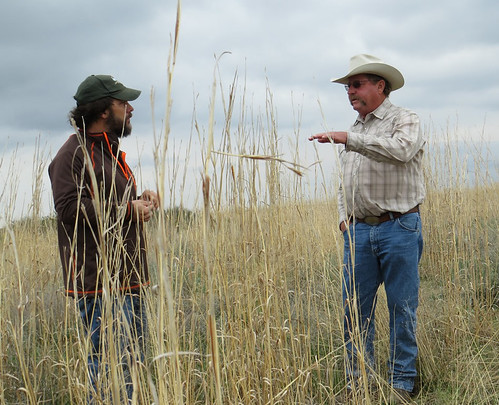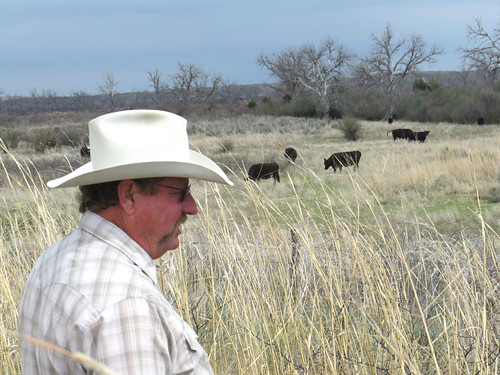
By Sandra Murphy, Lesser Prairie-Chicken Initiative
USDA’s Natural Resources Conservation Service (NRCS) works with ranchers and partners to improve habitat for lesser prairie-chicken through the Lesser Prairie-Chicken Initiative (LPCI). Focusing on privately-owned lands, the initiative covers five western states. About 95 percent of lesser prairie-chicken habitat is located on private lands. Sandra Murphy is communications specialist for LPCI, a partnership led by NRCS. — Justin Fritscher, NRCS
On a late April morning in southwest Kansas, sand bluestem sways over rancher Bill Barby’s head. A medley of other native grasses — little bluestem, sand lovegrass, and prairie sandreed, and more — fill the pasture around him, providing food for his cattle as well as habitat for the lesser prairie-chicken, a threatened species.
Despite the abundance of grass these days, Barby can easily recall the devastating drought that recently gripped the Southern Great Plains and brought forage production to a standstill.
“In 2011, I lost most of my sand lovegrass and some of my little bluestem,” he said. “It was a shock to have that die.”
During the worst two years of the drought, 2011 and 2012, temperatures soared to record highs. Rainfall plummeted — in some areas to the lowest levels in more than a century. Record numbers of wildfires burned, crops and pastures withered, streams ran dry, wildlife populations dwindled, trees died, and dust storms darkened the sky.
“It was a tough couple of years to be a prairie grass, let alone a prairie-chicken,” said Christian Hagen, science adviser for the Lesser Prairie-Chicken Initiative (LPCI). The partnership, led by USDA’s Natural Resources Conservation Service, leverages Farm Bill funds to help ranchers and farmers voluntarily enhance lesser prairie-chicken habitat while improving the long-term sustainability of their agricultural operations.
LPCI field staff work one-on-one with ranchers to develop a grazing plan that supports their cattle operation as well as providing habitat for wildlife like prairie-chicken. The plan identifies strategies to build grassland health and resiliency so that the vegetation is better able to survive drought, and it lays out a course of action to follow when a drought occurs.
When Barby acquired this 4,000-acre ranch in 2007, he enrolled in NRCS’ Environmental Quality Incentives Program (EQIP) right away. Through EQIP, he received technical and financial assistance to develop a conservation plan and put into place a grazing system that allowed portions of the range to rest during the growing season.
By following his conservation plan, Barby had good grass health going into the drought. As the hot, dry weather intensified, he followed the drought contingency strategies outlined in his plan, including removing cattle from the range.
“We’ve met many ranchers who’ve told us that their conservation plans have helped them maintain their herds and their business in the face of drought,” Hagen said, “By restoring native grasses and investing in conservation, their ranches have become more resilient in the face of extreme weather.”
Barby is currently enrolled in NRCS’ Conservation Stewardship Program (CSP), through which he continues to refine his operation and maintain habitat for the lesser prairie-chicken and other grassland wildlife.
For Hagen, that commitment to long-term sustainability for both ranch operations and rangeland is critical for lesser prairie-chickens.
“When landowners like Bill use LPCI assistance to plan for habitat resiliency through the next drought, it makes all the difference for the prairie chicken, which depends on healthy prairie through thick and thin,” he says.
As Barby looks out over the pasture where his cattle are grazing, he emphasizes the importance of federal conservation programs in helping him meet his ranching goals.
“I couldn’t be anywhere near as close to getting my ranch in shape if I didn’t have these programs,” he says. “The things I do for conservation are things I want to do for my ranch anyway, so for me they go hand in hand.”
Running his hand over a stalk of sand bluestem, he adds: “I’m not afraid of drought after seeing I can manage through it. When the next one comes, I'll have confidence to deal with it.”
LPCI is one of several NRCS landscape conservation initiatives working to enhance habitat for at-risk species while maintaining a vibrant agricultural sector. Producers are working with NRCS to also restore and protect habitat for sage grouse and southwestern willow flycatcher while making their lands more resilient to drought.
Learn more about the Lesser Prairie-Chicken Initiative.

